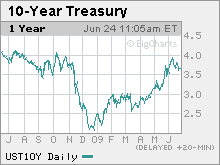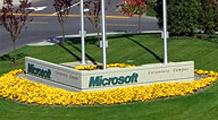What a drop in Treasurys means for stocks
If bond yields go on the rise again, equities aren't likely to suffer -- at least for now.

| MMA | 0.69% |
| $10K MMA | 0.42% |
| 6 month CD | 0.94% |
| 1 yr CD | 1.49% |
| 5 yr CD | 1.93% |
NEW YORK (Fortune) -- The conventional wisdom about stocks and bonds is that when one goes up, the other goes down. In other words, rising treasury yields -- meaning lower treasury prices -- should spell trouble for equities.
But so far this year, ten-year bond yields and stock prices have marched in lock-step: When yields hit highs of almost 4%, stocks also soared, and when bonds began to drop last week, so too did equities. Now investors are wondering: if rates rise again, will stocks increase too, or has any correlation been turned on its ear?
Market watchers are having a hard time figuring that out, given the unusual nature of the current economic environment. When the so-called flight to quality drove up treasury prices last fall, yields plunged to deep lows. Investors' appetite for risk returned in the spring, and many began buying equities instead. But optimism isn't all that's boosting treasury yields: There's also the fear of inflation, as well as the possibility that China -- a key buyer of U.S. treasurys -- will close its wallet because of concerns over the U.S.'s credit quality.
When strategists at Bank of America's Merrill Lynch and Barclays looked at the relationship between treasury yields and stock prices over the last few decades, they came up with very different results.
Bank of America small-cap strategist Steven DeSanctis compared the performance of small, large, and mid-size stocks with 10-year treasury yields from 1978 to 2008, and reported that, when yields went up, stock prices went down.
"As rates move higher, equities perform below average," he said. DeSanctis attributes the relationship in part to simple equity analysis: "When you're looking at the next five or ten years of cash flow and valuing a company, you discount it by the interest rate. As the interest rate rises, the value of the company declines," he says.
Meanwhile, Barry Knapp, an equities strategist at Barclays, reached a much different conclusion when he compared the performance of different S&P sectors with treasury rates from 1974 to 2009.
Knapp found that several areas, including energy, tech, and materials, did well when yields rose. When DeSanctis broke his own study down into sectors, he found that those groups actually did the worst.
Knapp believes one can connect stock and bond performance -- but it has to be within specific contexts. "There is a difference between a higher rate environment and a lower rate environment," he says. "When the ten-year yield is 5% or lower, the correlation between the yield and equities tends to be positive. But when it is above, then it becomes negative."
DeSanctis agrees on this point. "Right now, interest rates are still relatively low," he says. "The improvement in the economy and the fact that credit spreads are narrowing trumps changes [in yields]."
As long as we're in a low rate environment, Knapp believes stocks will rise alongside bond yields. When he compared the performance of small-caps against ten-year yields over the last three years -- when rates have been low -- he found a positive correlation. Rates rose in a controlled manner, and so did stocks.
As long as we're in that situation, says Knapp, a few sectors are likely to outperform. He says stocks in the energy, materials, and industrials realms will benefit from rising yields and inflation expectations.
Surprisingly, Knapp's study shows that consumer discretionary and consumer staples -- two sectors often viewed as diametrically opposed because the former is cyclical and the latter is defensive -- both do poorly when rates rise in a controlled manner.
When yields go up, he says, consumers are likely to spend less, thus hurting discretionary sales. But an increase in rates also signifies an improving economic outlook, spurring investors to shun slower-growing staples.
Should rates climb past 5%, we may enter Knapp's second scenario, where yields rise enough to cut into companies' earnings and slow the overall economy.
But don't expect bonds to rival equities for investors' attention anytime soon, says Bill Quinn, chairman of American Beacon Advisors: "Right now, stocks markets are still way undervalued compared to interest rates."
Quinn notes that the S&P 500 (SPX) currently has a price to earnings ratio of 15, which equates to an earnings yield (the inverse of the PE ratio) of about 7%. Compared with a 4% yield on a treasury, he says, there's no competition.
Like Knapp, however, Quinn says treasury yields will have an adverse impact on equities if they go too high. "Should treasury yields go to 5 or 6%, people will worry," he says. "But even a modest increase at this point won't be too damaging for stocks." ![]()
-
 The retail giant tops the Fortune 500 for the second year in a row. Who else made the list? More
The retail giant tops the Fortune 500 for the second year in a row. Who else made the list? More -
 This group of companies is all about social networking to connect with their customers. More
This group of companies is all about social networking to connect with their customers. More -
 The fight over the cholesterol medication is keeping a generic version from hitting the market. More
The fight over the cholesterol medication is keeping a generic version from hitting the market. More -
 Bin Laden may be dead, but the terrorist group he led doesn't need his money. More
Bin Laden may be dead, but the terrorist group he led doesn't need his money. More -
 U.S. real estate might be a mess, but in other parts of the world, home prices are jumping. More
U.S. real estate might be a mess, but in other parts of the world, home prices are jumping. More -
 Libya's output is a fraction of global production, but it's crucial to the nation's economy. More
Libya's output is a fraction of global production, but it's crucial to the nation's economy. More -
 Once rates start to rise, things could get ugly fast for our neighbors to the north. More
Once rates start to rise, things could get ugly fast for our neighbors to the north. More








